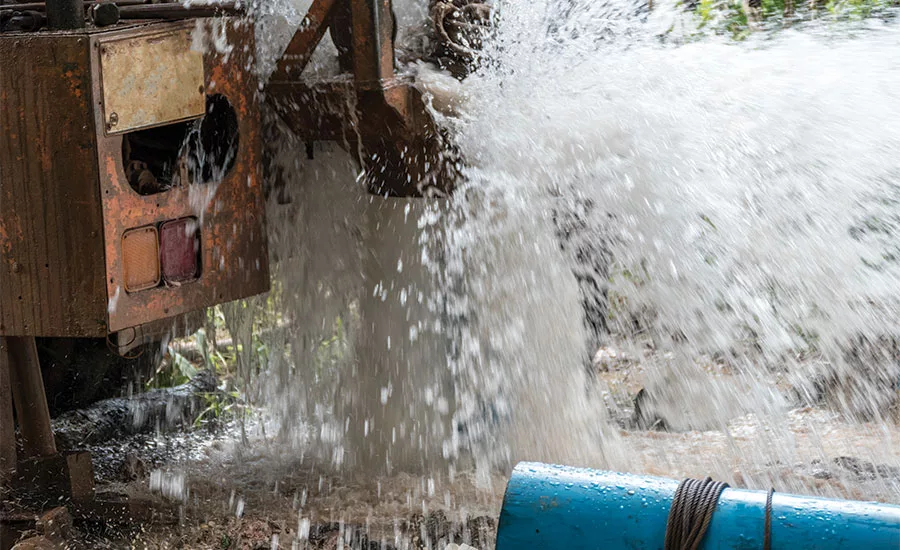What if a Water Well Doesn’t Clear During Development?

A while back, I wrote about gravel packs and well development, but I have had several calls and emails about wells that wouldn’t clear during development. Some of these wells just needed a little more development to consolidate and settle the gravel pack. Usually, more aggressive swabbing and air lift does it, but I have seen wells that didn’t want to clear no matter what we did. On several of these projects, the same problem occurred: screen placement.
When drilling a large capacity well that you plan to gravel pack, you must know exactly where the producing formation is located. A carefully logged and sampled pilot hole is essential. Exact depths will allow you to space your screen and casing properly, and good samples will allow you to select the proper screen-slot size and gravel size. If you plan to produce a single sand, at the bottom of the hole, you should know where the top of the sand is and carefully log the bottom. It is common to drill some rat-hole below the production to allow for slump or cuttings falling in while you are running casing.
Things get a little more interesting when the production is layered sand, clay, sand, etc., all of different thicknesses. Good, careful logging is important. Screens set in a clay formation won’t produce worth a hoot. Since large-diameter, wire-wrapped, stainless steel screens are expensive and you want to maximize production, your well design should only screen the producing zones. Run blank pipe between screens in the clay zones since they won’t produce anyway. With wire-wrapped screens, I use schedule-10 stainless blank. It looks thin, and it is, but it’s still stronger than the screen so it shouldn’t be a problem. When you get the screen, blank, screen, blank assembly in the hole, you change over to whatever casing you have designed. I have seen wells with as many as 20 screens of various lengths, with blank between them, to produce the maximum amount of water. One caveat on this: Some states will not allow you to co-mingle aquifers. But as long as you are producing from the same general aquifer, no problem.
As you can see, this can lead to an interesting math problem. Your drilled depths and your casing tally must line up exactly. We generally do this multiple times to cut errors. If I have an engineer on location, and a geologist, I give them the casing tally and we all figure it independently. If we all get the same numbers, good. If not, you better figure out where the error is before you run casing. Some drillers just screen the entire formation, top to bottom, but this is not really a good practice. First, screens are expensive, and a lot of it will be wasted in non-producing formations. Second, the clay formations behind the screens will cloud the water. Better to blank off the clay.
This has been the most common problem I have seen during development of these wells. Simply put, the screen is in the wrong place. Nearby production will flow up or down through the gravel pack, to some extent, but the clay will cloud the water.
Solutions to this problem, in order of time and money, start with continuing to develop the well. This works if the clay formation is not very water sensitive. You can often develop out the loose clay particles. If this doesn’t do it, consider chemical treatment to stabilize the clay. There are many new and good products on the market that you can jet through the screen to stabilize the clay. So, talk to a good mud engineer.
Click here to read more experiences and find tips for troubleshooting water well problems!
If the well still doesn’t clear, you are going to need to figure out where the cloudy water is coming from. The easiest way is with a camera and test pump. Often, you will find that almost all of the well is producing clear, but a short section of screen just won’t clear. Pump the well while you lower the camera and you will find the problem. Aggressive development and/or chemical treatment in this area will be necessary. Two commonly used methods to blind a screen are either a short, blank liner across the problem area (this works well on deeper screens that you don’t anticipate setting a pump through) or a cement squeeze. This is done by setting a packer above and below the problem area and pumping special cement through the screen to isolate the formation. The cement must be thin enough to pump through the screen slots, but thick enough to still do its job. In cases of very fine screen slot size, you may have to run a casing ripper in and make some holes. One caution: Don’t tear up the screen so badly that you allow your gravel pack to flow into the well. A few holes will work.
I have done this on several wells with great success. If I can help, call or email me.
For more Wayne Nash columns, visit www.thedriller.com/wayne.
Looking for a reprint of this article?
From high-res PDFs to custom plaques, order your copy today!









